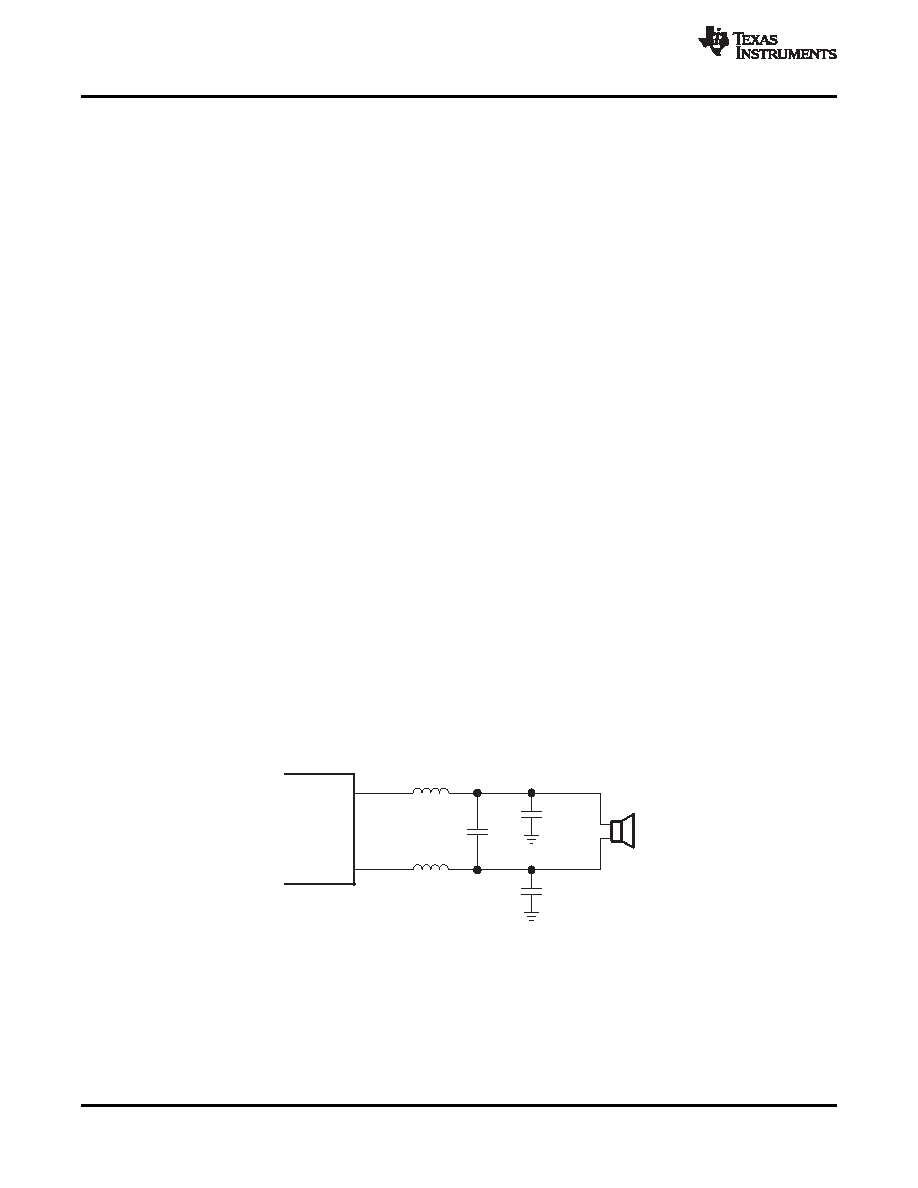- 您現(xiàn)在的位置:買賣IC網(wǎng) > PDF目錄98272 > TPA3004D2PHPG4 (TEXAS INSTRUMENTS INC) 2 CHANNEL(S), VOLUME CONTROL CIRCUIT, PQFP48 PDF資料下載
參數(shù)資料
| 型號(hào): | TPA3004D2PHPG4 |
| 廠商: | TEXAS INSTRUMENTS INC |
| 元件分類: | 音頻控制 |
| 英文描述: | 2 CHANNEL(S), VOLUME CONTROL CIRCUIT, PQFP48 |
| 封裝: | GREEN, PLASTIC, HTQFP-48 |
| 文件頁(yè)數(shù): | 17/46頁(yè) |
| 文件大小: | 838K |
| 代理商: | TPA3004D2PHPG4 |
第1頁(yè)第2頁(yè)第3頁(yè)第4頁(yè)第5頁(yè)第6頁(yè)第7頁(yè)第8頁(yè)第9頁(yè)第10頁(yè)第11頁(yè)第12頁(yè)第13頁(yè)第14頁(yè)第15頁(yè)第16頁(yè)當(dāng)前第17頁(yè)第18頁(yè)第19頁(yè)第20頁(yè)第21頁(yè)第22頁(yè)第23頁(yè)第24頁(yè)第25頁(yè)第26頁(yè)第27頁(yè)第28頁(yè)第29頁(yè)第30頁(yè)第31頁(yè)第32頁(yè)第33頁(yè)第34頁(yè)第35頁(yè)第36頁(yè)第37頁(yè)第38頁(yè)第39頁(yè)第40頁(yè)第41頁(yè)第42頁(yè)第43頁(yè)第44頁(yè)第45頁(yè)第46頁(yè)

Efficiency (theoretical, %)
+ RL RL ) rds(on)
100%
+ 8 (8 ) 0.58)
100%
+ 93.24%
P
(total)
+ P
O
Efficiency
+ 7.5 W
0.9324
+ 8.04 W
Other losses + P(total)(measured) * P(total) (theoretical) + 8.43 * 8.04 + 0.387 W
P
(dis) +
0.387 W * (14 V
14.3 mA) + 0.19 W
0.22
F
0.22
F
1
F
15
H
15
H
OUTP
OUTN
L1
L2
C1
C2
C3
SLOS407E – FEBRUARY 2003 – REVISED JANUARY 2011
www.ti.com
Damage may occur if the voice coil cannot handle the additional heat generated from the high-frequency
switching current. The amount of power dissipated in the speaker may be estimated by first considering the
overall efficiency of the system. If the on-resistance (rds(on)) of the output transistors is considered to cause the
dominant loss in the system, then the maximum theoretical efficiency for the TPA3004D2 with an 8-
load is as
follows:
(1)
The maximum measured output power is approximately 7.5 W with an 12-V power supply. The total theoretical
power supplied (P(total)) for this worst-case condition would therefore be as follows:
(2)
The efficiency measured in the lab using an 8-
speaker was 89%. The power not accounted for as dissipated
across the rds(on) may be calculated by simply subtracting the theoretical power from the measured power:
(3)
The quiescent supply current at 14 V is measured to be 14.3 mA. It can be assumed that the quiescent current
encapsulates all remaining losses in the device, i.e., biasing and switching losses. It may be assumed that any
remaining power is dissipated in the speaker and is calculated as follows:
(4)
Note that these calculations are for the worst-case condition of 7.5 W delivered to the speaker. Since the 0.19 W
is only 2.5% of the power delivered to the speaker, it may be concluded that the amount of power actually
dissipated in the speaker is relatively insignificant. Furthermore, this power dissipated is well within the
specifications of most loudspeaker drivers in a system, as the power rating is typically selected to handle the
power generated from a clipping waveform.
When to Use an Output Filter
Design the TPA3004D2 without the filter if the traces from amplifier to speaker are short (< 1 inch). Powered
speakers, where the speaker is in the same enclosure as the amplifier, is a typical application for class-D without
a filter.
Most applications require a ferrite bead filter. The ferrite filter reduces EMI around 1 MHz and higher (FCC and
CE only test radiated emissions greater than 30 MHz). When selecting a ferrite bead, choose one with high
impedance at high frequencies, but very low impedance at low frequencies.
Use a LC output filter if there are low frequency (<1 MHz) EMI sensitive circuits and/or there are long wires from
the amplifier to the speaker.
Figure 39. Typical LC Output Filter, Cutoff Frequency of 27 kHz, Speaker Impedance = 4
24
Copyright 2003–2011, Texas Instruments Incorporated
Product Folder Link(s): TPA3004D2
相關(guān)PDF資料 |
PDF描述 |
|---|---|
| TPA3005D2PHPR | 6 W, 2 CHANNEL, AUDIO AMPLIFIER, PQFP48 |
| TPA3005D2PHP | 6 W, 2 CHANNEL, AUDIO AMPLIFIER, PQFP48 |
| TPA3005D2PHPG4 | 6 W, 2 CHANNEL, AUDIO AMPLIFIER, PQFP48 |
| TPA3005D2PHPRG4 | 6 W, 2 CHANNEL, AUDIO AMPLIFIER, PQFP48 |
| TPA3007D1PWR | 6.5 W, 1 CHANNEL, AUDIO AMPLIFIER, PDSO24 |
相關(guān)代理商/技術(shù)參數(shù) |
參數(shù)描述 |
|---|---|
| TPA3004D2PHPR | 功能描述:音頻放大器 Stereo Hi-Pwr Filter-Free Class-D RoHS:否 制造商:STMicroelectronics 產(chǎn)品:General Purpose Audio Amplifiers 輸出類型:Digital 輸出功率: THD + 噪聲: 工作電源電壓:3.3 V 電源電流: 最大功率耗散: 最大工作溫度: 安裝風(fēng)格:SMD/SMT 封裝 / 箱體:TQFP-64 封裝:Reel |
| TPA3004D2PHPR | 制造商:Texas Instruments 功能描述:AUDIO POWER AMPLIFIER IC |
| TPA3004D2PHPRG4 | 功能描述:音頻放大器 Stereo Hi-Pwr Filter-Free Class-D RoHS:否 制造商:STMicroelectronics 產(chǎn)品:General Purpose Audio Amplifiers 輸出類型:Digital 輸出功率: THD + 噪聲: 工作電源電壓:3.3 V 電源電流: 最大功率耗散: 最大工作溫度: 安裝風(fēng)格:SMD/SMT 封裝 / 箱體:TQFP-64 封裝:Reel |
| TPA3005D2 | 制造商:TI 制造商全稱:Texas Instruments 功能描述:6-W STEREO CLASS-D AUDIO POWER AMPLIFIER |
| TPA3005D2EVM | 功能描述:音頻 IC 開(kāi)發(fā)工具 TPA3005D2 Eval Mod RoHS:否 制造商:Texas Instruments 產(chǎn)品:Evaluation Kits 類型:Audio Amplifiers 工具用于評(píng)估:TAS5614L 工作電源電壓:12 V to 38 V |
發(fā)布緊急采購(gòu),3分鐘左右您將得到回復(fù)。